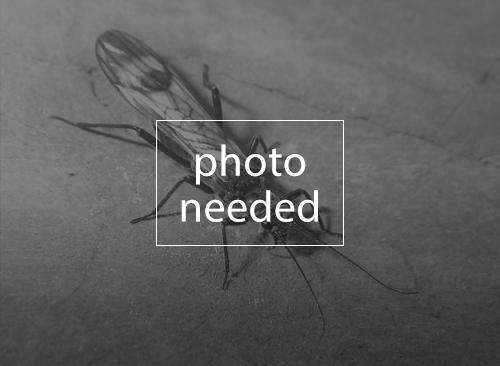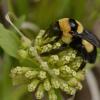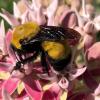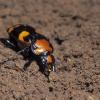
Hylaeus kona is a small bee endemic to the island of Hawaii in Hawaii. It is similar to H. kokeensis, differing by the grooved scape, marked mandible, and other details. It is known from very few collections, and appears to be associated with the tree Chamaesyce olowaluana.
Males
Head all yellow below the antennae, color extending up along eye; mandible, scape, median plate of wing, legs, and pronotum also marked with yellow. Scape distinctively shaped, strongly convex on the median margin, with a conspicuous groove underneath. Hairs at the apex of the abdomen black, erect.
Females
Face with a long narrow stripe along the eye, scape and mandible unmarked; other marks as in the male. Hylaeus kona is one of the most extensively marked Hawaiian species. The only other species with a mark on the median plate is H. kokeensis, a species from Kauai that has a narrower, unmarked scape without a groove.
Taxonomic Status
Hylaeus kona was described as Prosopis kona by Blackburn (Blackburn and Cameron, 1886), and transferred to the new genus Nesoprosopis by Perkins (1899). Nesoprosopis was reduced to a subgenus of Hylaeus by Meade-Waldo (1923). The most recent taxonomic treatment was Daly and Magnacca (2003).
Hylaeus kona inhabits dry to mesic forests. Most recent collections have come from Chamaesyce olowaluana (akoko) trees. Nesting habits are not known, but based on related species it probably nests in wood.
Hylaeus kona is restricted to the area between Hualalai, Mauna Kea, and Mauna Loa on Hawaii. Recent collections are from the Puu Waawaa Wildlife Sanctuary and the Pohakuloa Training Area. It may also occur on the slopes of Mauna Loa south of Hualalai, but this area has not been investigated.
Xerces Red List Status: Critically Imperiled
Other Rankings:
Canada – Species at Risk Act: N/A
Canada – provincial status: N/A
Mexico: N/A
USA – Endangered Species Act: Species of Concern
USA – state status: HI: Species of Concern
NatureServe: GNR
IUCN Red List: N/A
This species is extremely rare; it is found in low numbers in a narrow range. Originally, U.S. Federal listings of rare and endangered species classed H. kona as a “Category 2” Candidate Specie s about which more information was needed before it could be considered for listing. This status was based on recognition that Hawaiian bees in general were becoming rarer and little was known about their conservation status. Data were never gathered to document whether or not this species should be proposed for listing. It is currently considered to be a “Species of Concern” or a “Special Status Species” by the U.S. Fish and Wildlife Service and the Hawaii Division of Forestry and Wildlife.
The rarity of H. kona and lack of knowledge about its requirements make it difficult to assess threats. The habitat it lives in has been heavily impacted by grazing and other factors, but the large potential area and lack of access makes it difficult to assess how much remains, or what the true distribution of H. kona is. Although it was found on other flowers at Pohakuloa, it appears to favor Chamaesyce olowaluana. In general, C. olowaluana supports a much larger bee fauna than is found in nearby forest. It is also extremely vulnerable to grazing by feral sheep, which prevents reproduction. As a result, there are relatively few trees in the Puu Waawaa/Pohakuloa area. Lack of nest sites due to declines in the populations of wood-boring Plagithmysus longhorn beetles may also be a factor, but has not been investigated.
The top priority is to identify extant populations and document the continued existence of the species. Both sites where H. kona is known to be found are protected under the auspices of the State of Hawaii or the U.S. Army, though they may not be activelymanaged for habitat conservation; other populations may be found on private land. The trees that H. kona were collected on at Puu Waawaa lie just outside a sheep fence; including them in the fenced area and/or planting C. olowaluana within the exclosure would help greatly. All areas are highly vulnerable to fire.
Blackburn, T., and P. Cameron. 1886. On the Hymenoptera of the Hawaiian Islands. Proc. Manchester Literary Philos. Soc. 25:34-183.
Daly, H. V., and K. N. Magnacca. 2003. Insects of Hawaii, Vol. 17: Hawaiian Hylaeus (Nesoprosopis) Bees (Hymenoptera: Apoidea). University of Hawaii Press, Honolulu. 234 pp.
Magnacca, K. N. 2005. Evolution of Hylaeus (Nesoprosopis) Bees in Hawaii. Ph.D. dissertation, Corne ll University.
Meade-Waldo, G. 1923. Hymenoptera, fam. Apidae, subfam. Prosopidae, fasc. 181. Pp. 1-45 in P. Wytsman (ed.), Genera Insectorum. L. Desmet-Verteneuil, Brussels.
Perkins, R. C. L. 1899. Hymenoptera, Aculeata. Pp. 1-115 in D. Sharp (ed.), Fauna Hawaiiensis, Vol. 1. Cambridge University Press, Cambridge, United Kingdom.
Citation
Magnacca, K. N. 2005. Species Profile: Hylaeus kona. In Shepherd, M. D., D. M. Vaughan, and S. H. Black (Eds). Red List of Pollinator Insects of North America. CD-ROM Version 1 (May 2005). Portland, OR: The Xerces Society for Invertebrate Conservation
Profile prepared by Karl Magnacca, USGS-BRD, Kilauea Field Station





